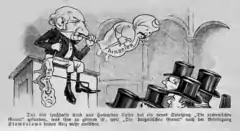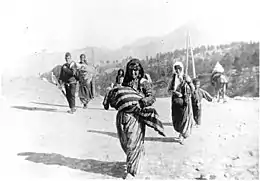Justifying Genocide
Justifying Genocide: Germany and the Armenians from Bismarck to Hitler is a book by Stefan Ihrig which explores how violence against the Ottoman Armenians, from the 1890s massacres to the Armenian Genocide, influenced Germany.[1] It illustrates how the topic was debated in Germany after World War I and how these debates and historical perceptions influenced the Holocaust. The book was published in 2016 by Harvard University Press.[2] Reviews credited the book for being convincing while offering an original perspective, while offering minor criticisms.
Content

The book expands on Ihrig's previous book, Atatürk in the Nazi Imagination (2014),[3] and is based on examination of contemporary German publications.[4][5] Ihrig writes that his book is about "Germany and its road to the Holocaust",[6][7] and only secondarily about Turks or Armenians. The book covers the period from the 1878 Treaty of San Stefano through World War II;[3] Ihrig argues that the German media took a consistently pro-Turkish line in justifying massacres of Armenians throughout this period.[7]
Ihrig chronicles how the German chancellor, Otto von Bismarck, encouraged the Ottoman rulers not to implement the guarantees of minority rights encoded in the 1878 treaty.[3] During the 1890s, the German press reported extensively on the Hamidian massacres of Armenians, labeling them "Völkermord" (the German word for genocide) decades before the term genocide was coined in English.[7] In order to its build its relationship with the Ottoman Empire, the German government defended the massacres as justified. By the 1890s, Ihrig finds a consistent anti-Armenianism in the German press (especially right-wing media), which he compares to antisemitism.[4][7] Anti-Armenian books such as those by Karl May, Hans Barth, and Alfred Körte were also published.[7]

During the Armenian Genocide, Ihrig states that Germany could have known "everything" about the fate of the Armenians as it was ongoing.[7] However, the German press repeated uncritically denial of the genocide by German officials long after the facts were widely known, as well as justification and rationalization of the killings.[4] Although Ihrig rejects the claim (proposed by Vahakn Dadrian) that the genocide resulted from a joint German–Ottoman decision,[7] Ihrig concludes that Germany made the decision to "sacrifice the Armenians as the price of preserving Ottoman goodwill toward Germany".[4]
Ihrig covers the 1921 trial of Soghomon Tehlirian for the assassination of Talat Pasha in Berlin, which raised the profile of the genocide in Germany. Many newspapers began to use the word Völkermord or the formula Ausrottung eines Volkes (extermination of a people) in the modern meaning of "genocide", as opposed to the less specific terms of "Armenian Horrors" or "Armenian massacres".[8][3] However, according to Ihrig, acknowledgment of genocide did not translate into condemnation, instead it led to the victory of the faction that portrayed the genocide as necessary and justified, primarily because the Armenians were judged to have stabbed the Ottoman Empire in the back.[9][3][10] For many German nationalists in the Weimar Republic, Ihrig writes, "genocide was a 'reasonable,' 'justifiable,' if not unavoidable cost of doing political and military business in the twentieth century".[11][3] On the other hand, Ihrig profiles Franz Werfel, Armin Wegner, Max Erwin von Scheubner-Richter, and Johannes Lepsius, who fought to inform the public about the Armenian plight, help Armenians, and ward off the rise of Nazism.[7] In Nazi racial theory, "Armenoids" were considered an inferior race and even "Eastern Jews".[10][3]
Ihrig considers the Armenian genocide to be the "double original sin" of the twentieth century, first because it happened, and second because it went unpunished; thus it is, according to Ihrig, a sin not only of the perpetrators but also the bystanders.[12][7] He concludes that "There can be no doubt that the Nazis had incorporated the Armenian Genocide, its 'lessons,' tactics, and 'benefits,' into their own worldview and their view of the new racial order they were building."[13][10] Although he does not go as far as to state that Nazis were directly inspired by the Armenian Genocide to commit the Holocaust, he does state that they admired the Turkish use of genocide as a tool of national rebirth, creating a "postgenocidal paradise".[4][3]
Reviews
Kirkus Reviews calls the book "A groundbreaking academic study that shows how Germany derived from the Armenian genocide 'a plethora of recipes' to address its own ethnic problems".[14] Hungarian historian Péter Pál Kránitz states that "Ihrig's findings are significant for international scholars of genocide and the Holocaust".[10] Armenian political scientist Vahram Ter-Matevosyan credits Ihrig with challenging "the deep-seated concepts and approaches about the Armenian Genocide discourse".[7] Vahagn Avedian states that Ihrig conducted "meticulous research" and produced "a highly welcomed contribution to the field of genocide studies".[3] Lawrence Douglas considers the book fascinating, highly readable, and convincing.[1]
German historian Jürgen Zimmerer states that Ihrig's study rests on intentionalist assumptions (that the Holocaust was ideologically based and planned in advance), a theory which is by no means completely accepted among scholars of the Holocaust. Nevertheless, he considers the book "important and inspiring" especially for historians of Germany.[15] According to historian Jo Laycock, Ihrig's book is "the most detailed and wide ranging analysis to date of the evolution of German representations of the Armenians and responses to the Armenian Genocide of 1915".[16] Alp Yenen states that Ihrig takes a highly critical stance towards genocide relativism, but is less critical of falsehoods on the pro-Armenian side, such as Tehlirian's false testimony that he was present when his family was murdered. Although faulting the book for stinting on discussion of theory, Yenen states that it is "a timely contribution to various fields and offers complex and thought provoking arguments", while providing a comprehensive overview of German responses to the Armenian question.[6]
Awards
The book received the 2017 Dr. Sona Aronian Book Prize for Excellence in Armenian Studies by the National Association for Armenian Studies and Research.[17]
References
- "Justifying Genocide by Stefan Ihrig review: Germany's first taste of genocide". The Irish Times. Retrieved 2020-07-22.
- "Justifying Genocide: Germany and the Armenians from Bismarck to Hitler, by Stefan Ihrig (2016)". Not Even Past. 22 March 2017. Retrieved 21 November 2020.
- Avedian, Vahagn (20 November 2018). "Justifying genocide: Germany and the Armenians from Bismarck to Hitler, by Stefan Ihrig, Cambridge, MA, Harvard, 2016, 460 pp., $35.00 (HC), ISBN 978-0674504790". Nationalities Papers. 46 (3): 532–535. doi:10.1080/00905992.2017.1390980. S2CID 159627934.
- Chorbajian, Levon (11 July 2016). "Review Feature - The Armenian Genocide". E-International Relations. Retrieved 21 November 2020.
- Schwanitz, Wolfgang G. (January 2017). "Review of Ihrig, Stefan, Justifying Genocide: Germany and the Armenians from Bismarck to Hitler". H-Soz-u-Kult, H-Review. Retrieved 21 November 2020.
- Yenen, Alp (20 December 2017). "Ihrig, Stefan: Justifying genocide: Germany and the Armenians from Bismarck to Hitler" (PDF). Asiatische Studien - Études Asiatiques. 71 (3): 1039–1043. doi:10.1515/asia-2017-0053. S2CID 103441727.
- Ter-Matevosyan, Vahram (October 2017). "Book Review: Justifying Genocide: Germany and the Armenians from Bismarck to Hitler". Genocide Studies and Prevention. 11 (2): 106–108. doi:10.5038/1911-9933.11.2.1482.
- Ihrig 2016, p. 271.
- Ihrig 2016, p. 273.
- Kránitz, Péter Pál (2016). "Review of Justifying Genocide: Germany and the Armenians from Bismarck to Hitler". The Hungarian Historical Review. 5 (4): 916–920. ISSN 2063-8647. JSTOR 44390829.
- Ihrig 2016, p. 279.
- Ihrig 2016, p. 7.
- Ihrig 2016, p. 349.
- "Justifying Genocide". Kirkus Reviews. Retrieved 20 November 2020.
- Zimmerer, Jürgen (December 2018). "Stefan Ihrig. Justifying Genocide: Germany and the Armenians from Bismarck to Hitler". The American Historical Review. 123 (5): 1777–1778. doi:10.1093/ahr/rhy338.
- Laycock, Jo (March 2018). "Justifying Genocide: Germany and the Armenians from Bismarck to Hitler". German History. 36 (1): 116–118. doi:10.1093/gerhis/ghx083.
- Contributor, Guest (2017-12-18). "Stefan Ihrig and Abraham Terian Receive NAASR's Aronian Armenian Studies Book Prizes". The Armenian Weekly. Retrieved 2020-07-22.
Further reading
- Ihrig, Stefan (2016). Justifying Genocide: Germany and the Armenians from Bismark to Hitler. Harvard University Press. ISBN 978-0-674-50479-0.
- Tatoyan, Robert. "Stefan Ihrig, Justifying Genocide: Germany and the Armenians from Bismarck to Hitler, Cambridge, MA: Harvard University Press, 2016, ISBN: 978-0674504790; 472 pages" (PDF). International Journal of Armenian Genocide Studies. 3 (1): 88–101.